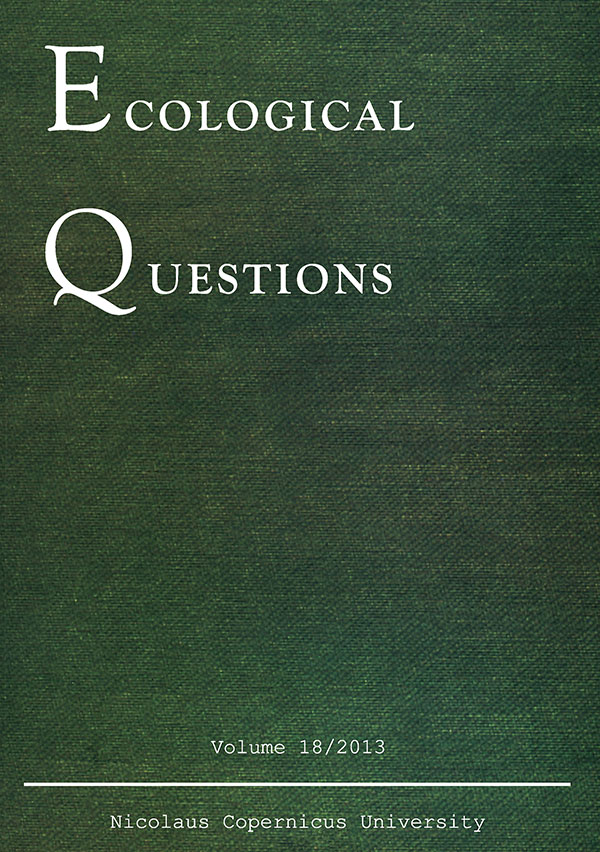Amphibian situation in urban environment – history of the common toad Bufo bufo in Kraków (Poland)
DOI:
https://doi.org/10.12775/ecoq-2013-0009Keywords
urbanization, water bodies, historical inventory data, revision of species distributionAbstract
Rapid urbanization processes are not neutral to the environment, especially amphibians. Their double-environment lifestyle makes them particularly vulnerable to negative changes in the environment. Inventory research on batrachofauna carried out in urban areas usually provides data on its current state, but there is little information about changes in its composition over the years. The aim of the study was to investigate the situation of amphibians in urban areas of Kraków (Poland) over the last 90 years. As an example of amphibian species the common toad Bufo bufo (Linnaeus, 1758) was selected, because of its widespread occurrence and high environmental plasticity. Three periods were chosen for the analysis: 1) before the Second World War (1928-1939), when the nature of the city seemed to be the least exposed to treats, 2) after the rapid urban transformation associated with the expansion of the territory of the city (1986 -1992), and 3) the present time. In order to determine the current situation of amphibians, in 2011-2012, 30 water bodies of Kraków were inventoried, with particular emphasis on the common toad. The occurrence of the same species in the city over the last 90 years was shown. The proportion of occupied habitat (POH) by the common toad (POH=0.57) is currently similar to the pre-Second World War proportion (POH=0.58). Between these two periods, there was a significant increase in the number of Bufo bufo in Kraków (POH=0.86). At that time the common toad was the only amphibian which increased, while the others declined. These results may suggest the high resistance of the species to the negative impact of urbanization during this period (loss and fragmentation of habitat and pollution). However, its resistance is limited, as evidenced by the recent decline of the species, just as most other amphibians of Kraków.References
Baillie J. E. M., Hilton-Taylor C. & Stuart S. N., 2004, A 2004 IUCN Red list of threatened species: A Global Species Assessment, IUCN, Gland, Switzerland and Cambridge, UK.
Beebee T. J. C. & Griffiths R. A., 2005, The amphibian decline crisis: a watershed for conservation biology?, Biological Conservation 125: 271-285. DOI 10.1016/j.biocon.2005.04.009
Cushman S. A., 2006, Effects of habitat loss and fragmentation on amphibians: a review and prospectus, Biological Conservation 128: 231-240. DOI 10.1016/j.biocon.2005.09.031
Głowaciński Z., 2003, Ropucha szara Bufo bufo (Linneus, 1758) [The common toad Bufo bufo (Linneus, 1758)], [in:] Z. Głowaciński, J. Rafiński (eds.), Atlas płazów i gadów Polski. Status – Rozmieszczenie – Ochrona [Atlas of the amphibians and reptiles of Poland. Status – Distribution – Conservation], Biblioteka Monitoringu Środowiska, IOŚ/IOP PAN, Kraków – Warszawa: 47-50.
Głowaciński Z. & Rafiński J., 2003, Atlas płazów i gadów Polski. Status – Rozmieszczenie – Ochrona [Atlas of the amphibians and reptiles of Poland. Status – Distri bution – Conservation], Biblioteka Monitoringu Środowiska, IOŚ/IOP PAN, Kraków – Warszawa.
Guzik M., Schimscheiner L., Zakrzewski M., Zamachowski W. & Zyśk A., 1996, Herpetofauna miasta Krakowa [Herpetofauna of the city of Kraków], Studia Ośr. Dok. Fizjograf. PAN, Kraków: 24: 247-262.
Hamer A. J. & McDonnell M. J., 2008, Amphibian ecology and conservation in the urbanising world: A review, Biological Conservation 141: 2432-2449. DOI 10.1016/j.biocon.2008.07.020
Juszczyk W., 1987, Płazy i gady krajowe [Amphibians and reptiles of Poland], PWN, Warszawa.
Juszczyk W., 1989, Płazy i gady miasta Krakowa w latach 1922-1979 [Amphibians and reptiles in the city of Kraków in 1922-1979], Przegląd Zoologiczny 33: 373-381.
Kawa K., Budzik K., Żuwała K. & Bury S., 2011, The amphibian species composition of selected Kraków water bodies over the last decades, [in:] P. Indykiewicz, L. Jerzak, J. Böhner, B. Kavanagh (eds), Urban Fauna. Studies of animal biology, ecology and conservation in European cities, Uniwersytet Techniczno-Przyrodniczy, Bydgoszcz: 349-356.
Kawalec W., 1998, Monitoring miejsc rozrodu populacji płazów w Krakowie [Monitoring of amphibians breeding sites of Kraków], Praca licencjacka, Zakład Anatomii Porównawczej, Uniwersytet Jagielloński, Kraków.
Miltner R. J., White D. & Yoder C., 2004, The biotic integrity of streams in urban and suburbanizing landscapes, Landscape and Urban Planning 69: 87-100. DOI 10.1016/j.landurbplan.2003.10.032
Najbar B., 2010, The occurrence of amphibians in Zielona Góra in 2005-2008, Fragmenta Faunistica 53: 181-194. DOI 10.3161/00159301FF2010.53.2.181
Ogielska M. & Kierzkowski P., 2010, Long term data on the amphibians of Wrocław, Fragmenta Faunistica 53: 195-2012. DOI 10.3161/00159301FF2010.53.2.195
Paul M. J. & Meyer J. L., 2001, Streams in the urban landscape, Annual Review of Ecology and Systematics 32: 333-365. DOI: 10.1146/annurev.ecolsys.32.081501.114040
Stebbins R. C. & Cohen N., 1995, Natural history of amphibians, Princeton University Press, Princeton.
Stuart S. N., Chanson J. S., Cox N. A., Young B. E., Rodrigues A. S. L., Fischman D. L. & Waller R. W., 2004, Status and trends of amphibian declines and extinctions worldwide, Science 306:1783-1786. DOI: 10.1126/science.1103538
Wilkinson J. W. & Buckley J., 2012, Amphibian Conservation in Britain, FrogLog 101: 12-13.
Downloads
Published
How to Cite
Issue
Section
Stats
Number of views and downloads: 734
Number of citations: 0



